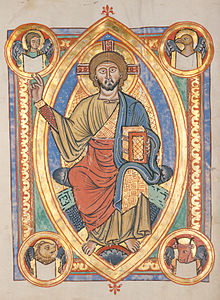Mandorla
In icons of the Eastern Orthodox Church, the mandorla is used to depict sacred moments that "transcend time and space", such as the Resurrection and the Transfiguration of Jesus Christ and the Dormition of the Theotokos.
The interior of the mandorla is usually undecorated, but may contain the symbols for Alpha and Omega (Α and Ω) or, less frequently, depictions of a starry sky or clouds.
In a famous Catholic Romanesque fresco of Jesus Christ in Glory in Sant Climent de Taüll, the scriptural inscription Ego Sum Lux Mundi ("I Am the Light of the World") is incorporated in the mandorla design.
[2] The tympanum at Conques has Christ, with a gesture carved in Romanesque sculpture, indicate the angels at his feet bearing candlesticks.
[3] In one special case, at Cervon (Nièvre), Jesus Christ is seated and surrounded by eight stars that resemble blooming flowers.

